In this post I’ll get super geeky about active vs. passive flexibility, why you should care about flexibility, and how each one can benefit your yoga practice.
What is flexibility?
Flexibility is the range of motion (ROM) available at a joint. If you are very flexible you will have a larger range of motion in your joints than a less flexible person.
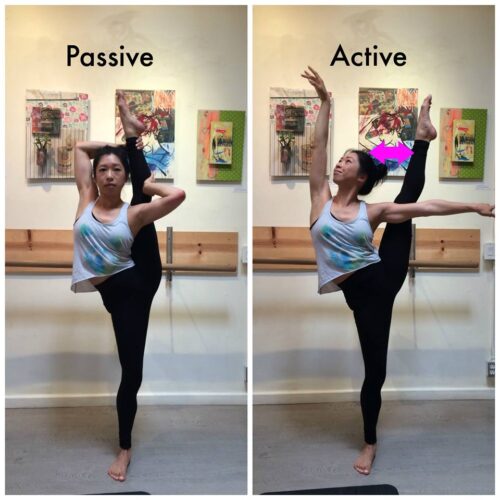
The difference between active and passive flexibility
Active flexibility is the range of motion a joint can move into without an external force helping it go there. Passive flexibility is the range of motion a joint can move into when there’s an external force helping it go there.
Usually your passive flexibility is larger than your active flexibility. This is because you can move into your passive range of motion with the help of external force such as a band, your hands, gravity, an assist from another person, etc.. Moving into the end of your active range of motion requires strength in the body part you’re moving.
Active flexibility is also known as mobility. Working on your mobility is a type of strength training where you only focus on becoming strong at your end ranges of motion. Many people prefer active flexibility over passive flexibility because they want to be able to control their range of motion without help from an external force.
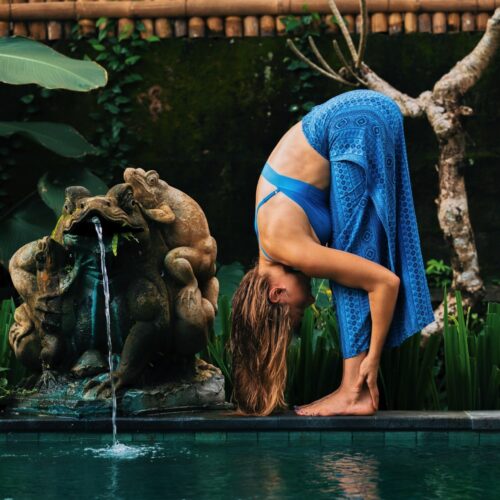
Tired of dealing with aching wrists in your practice?
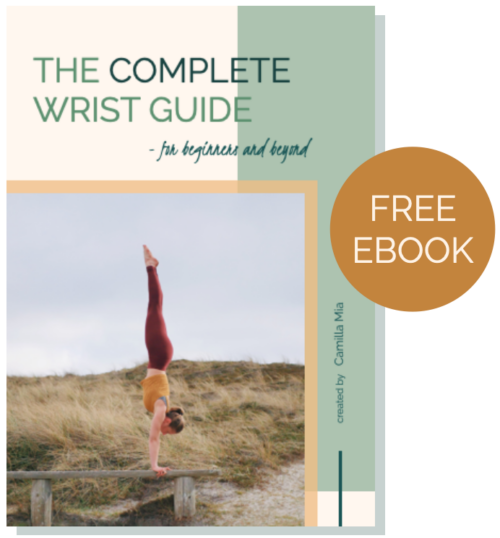
Get The Complete Wrist Guide so you can practice yoga, arm balances, and handstands with ease and stability!
The ebook includes 17 exercises that build strength and flexibility in your wrists and forearms, two exercise program templates, and a printable wrist exercise sheet, along with tips on how to position your hands and distribute weight in your palms for optimal comfort and balance.
Passive stretching
Passive stretching relies on bodyweight, a teacher, a band/strap, or another external force on a relaxed muscle. This type of flexibility relies largely on the elasticity of the connective tissues around the muscles.
Working on passive flexibility will help you increase and maintain a large range of motion, which is important to your progress in active flexibility. Passive flexibility is the foundation on which you can start building your active flexibility. You can turn passive flexibility into active flexibility by strengthening your muscles at your passive end range of motion.
With passive stretching, it’s important to note that you are not contracting or using your muscles but keeping the muscles relaxed. Passive stretches often require very little energy, commonly worked on when your goal is to increase your range of motion past your current comfort level.

Active stretching
Active stretching incorporates mobility and active movement. This type of flexibility relies largely on the strength of your muscles fibers to achieve the stretch, unaided by external forces such as your hand or a band. Active flexibility plays a large role in getting into different more advanced yoga poses safely. Having active flexibility means you have the strength to maintain integrity and stability in your joints in a deep yoga pose).
With active stretching, you are actively moving and engaging one muscle group to stretch another. This requires much more energy than passive stretching. There is less of a chance of over-stretching because you’re moving yourself into the position with strength and control.
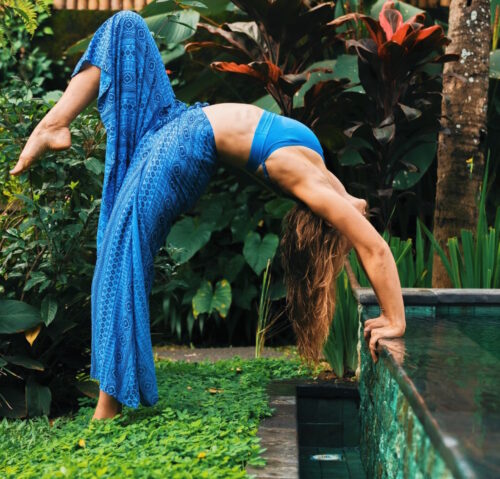
The issue with passive stretching
There’s a much higher risk of overstretching and injury in passive stretching because you’re relaxing the body part you’re stretching and letting an external force push/pull you into the stretch.
In active flexibility you’re moving into stretching positions using the strength and integrity of the body part you’re stretching. This makes active stretching much more controlled and lowers the risk of overstretching and injury significantly.
Imagine a person who has a lot of passive flexibility in their ankles but very limited active flexibility there. If they ever stumble and twist their ankle into the end of their passive range of motion, they are much more likely to injure themselves, because they don’t have strength (i.e. active flexibility) in the position their ankle twisted into. Therefore they cannot support themselves and protect the ankle joint in the vulnerable position it ended up in.
If you want to become resilient and resistant to injuries in the long run then work on turning your passive flexibility into active flexibility.
Is passive stretching bad?
If that’s the case, is passive stretching then bad for me?
Passive stretching is only bad when your passive flexibility is in huge excess of your active flexibility. If you’re only doing passive stretching you have a much higher risk of injury because you have a lot of range of motion in your joints that you can’t really control.
Passive stretching is definitely not all bad though. We just want to aim for a good balance between passive and active stretching. Passive stretching is still important because it let’s us expand the range of motion we have available in our joints.
You can’t build strength and control in a range of motion you cannot access so we need passive stretching to help us access a bigger range of motion. Active stretching helps us build strength in that range of motion. Therefore we absolutely need to do both to increase our overall flexibility and mobility!
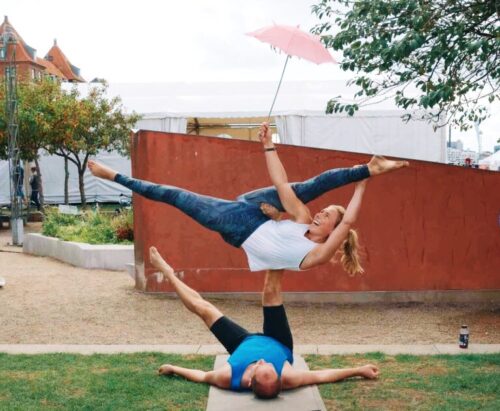
How to modify your yoga practice to include more active stretching
The problem in traditional yoga is that there’s a lack of active stretching compared to passive stretching. This creates an imbalance between active and passive flexibility in people who practice traditional yoga regularly, which can result in many of the common yoga-related injuries such as yoga butt syndrome, aches and pains in the lower back, shoulders, and knees.
In recent years, there’s been a call in recent years to modify the traditional yoga practice to make it more mobility and strength focused and avoid many of those yoga-related injuries.
Here’s how you can modify your yoga practice to include more elements of active stretching!
Sun Salutations & Standing postures of yoga
Have you ever tried doing a sun salutation with one foot on your yoga mat and one foot sliding on a blanket on a hard floor? It will completely change the way you engage and activate your muscles in those postures! Be prepared for sun salutations to require a lot more effort because you’ll be building strength in your range of motion.
Doing this with any standing pose like Warrior I, Warrior II, Peaceful Warrior, Skandasana, Wide Legged Forward Fold, Goddess Pose, Extended Side Angle, Triangle, High lunge, and Downward Facing Dog will begin to build a lot more active flexibility in the muscles of your inner thighs, your hamstrings, quads, hip flexors, etc.
Sock sliding practices
Putting on fuzzy socks and practicing directly on a hard floor is one of my favourite ways to change my yoga practice up every once in a while to make it a lot more active (plastic bags over your feet on a carpet will also do the trick!).
Instead of jumping from downdog to a forward fold at the top of your mat try sliding from one pose to another. You’ll quickly realise just how much more strength is needed to perform the movement.
Or try moving from skandasana on one side to the other, sliding into hanumanasana (the splits), pigeon pose, and other passive flexibility postures from yoga will be an entirely new experience because you now have to engage your muscles to move into them.
When is the best time to stretch?
Best time of day for passive stretching
Passive stretching calms the nervous system and helps us relax and cool-down.
Passive flexibility is best worked on either as a cool down after a workout or yoga session as your muscles will be warmer, and the chances of over-extending a cold or tight muscle is lessened or when you want to calm down at the end of the day to get ready to go to sleep.
Best time of day for active stretching
Active stretching requires more effort and can be quite energizing.
Active flexibility is best worked on either in the morning to help you wake up and warm up your joints at their current range of motion.
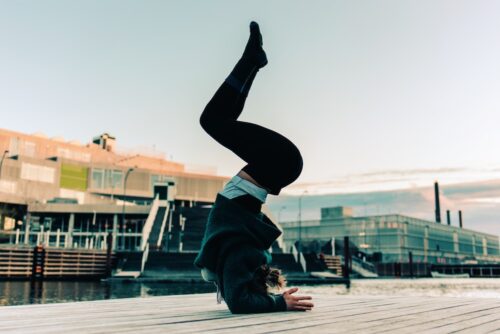
The flexibility you actually “own”
One of my mobility teachers calls the flexibility you can access right as you get out of bed in the morning without warming up the flexibility you actually “own”.
I really like that phrase because it puts an emphasis on building active flexibility because it’s available to us in everyday life. The type of flexibility we have available without needing to warm-up or do a full yoga session to access it. The type of flexibility we can control when we’re cold and haven’t moved our bodies for a while.
This is the type of flexibility I aim to build because it gives me more freedom in my body to be able to control and access a large range of motion whenever I want regardless of how I’ve moved my body on any given day.
Are you working on your flexibility? Are you balancing your passive stretching with active stretching? Please share any comments or questions below and let’s have a chat!

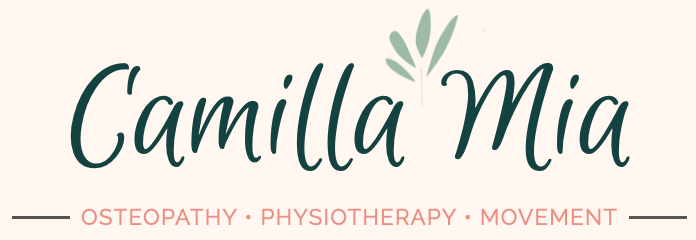
Very nice post, Camilla! Like your visual and descriptive examples. Both are so important, especially in balancing as closely as possible as you say. All the best in your studies!
Thanks Felipe! I’m glad you liked it.
All the best to you too!
What a brilliant explanation. Thank you for sharing. Luckily for me, my yoga classes are very active/ fitness based but we do balance it up with passive stretching. I qualified as a fitness instructor many years before I became a yoga teacher and I was stunned at how many yoga teachers were not adding strength to their classes. Lots of ‘hanging’ on joints. Eeek…I used to shudder.
My very first introduction to yoga was very short-lived because I could tell that I was way too “tight” to do even simple poses without risking injury. Now many years later I am getting some Muscle Activation Therapy (which has helped me previously) for a recent injury. My therapist (who is not a yoga practitioner) was explaining to me about the difference between active and passive stretching and the importance of finding stability through strength rather than a sole focus on flexibility for its own sake. Finding your article has really helped me to grasp the idea. Thank you.
Thank you 🙂😉✌🏾
You mentioned about active and passive flexibility; could You pls elaborate to identify them in aasanas. This will surely help in understanding what, when and how much to do.
Asanas build active flexibility when you engage correctly. Sometimes we can kind of just “hang out” in asanas and that makes them tend toward building passive rather than active flexibility.
Take front splits or hanumanasana for example – if you just slide into it without any engagement and staying in the pose passively, then you’re only improving your passive mobility. If you engage the muscles around your hips either pressing against the floor to resist collapse or engaging imagining that you’re trying to lift your legs even further into split, then that contraction is making you build active flexibility.
I hope this makes sense – let me know if you have more questions 🙂